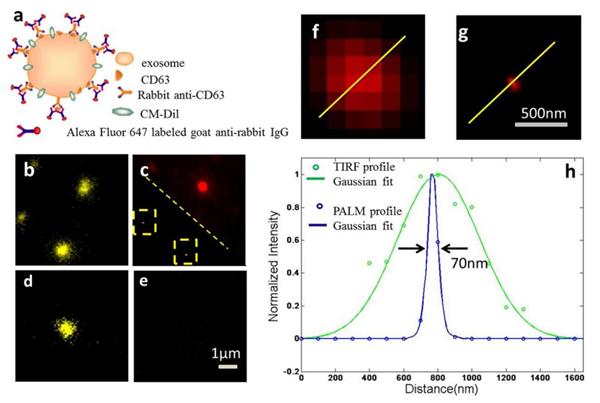Exosomes are vesicle-like vesicles secreted by cells, the contents of which include proteins, mRNA, DNA, and lipids. Exosomes have many biological functions as short- and long-range nanocarriers for intercellular communication. They allow the exchange of complex information between cells, as well as having the unique ability to migrate, target, and selectively internalize into specific cells, making them very promising delivery vehicles. Lifeasible offers exosome imaging services to better analyze the mechanisms by which exosomes play a role between cells.
 Figure 1. TIRF and PALM/STORM imaging of HeLa exosomes. (Chen et al., 2016)
Figure 1. TIRF and PALM/STORM imaging of HeLa exosomes. (Chen et al., 2016)
Lifeasible offers a variety of exosome imaging options, including labeling exosomes with magnetic contrast agents, nanoparticles, fluorescent proteins, organic dyes, luciferase, and others to track and explore the distribution of exosomes.
Based on the development of specific fluorescence techniques that can be used for tracking and imaging exosomes. We can customize fluorescent dyes, fluorescent proteins, or other fluorescent materials to label exosomes to help fluorescence imaging of exosomes.
Bioluminescence imaging (BLI) technology provides a whole-body picture of exosome biodistribution and is very reliable for exosome tracking because the labeling is intrinsic. Bioluminescence imaging (BLI) also provides data on the processes involved in exosomes, for example, revealing the mechanisms by which cells influence their microenvironment through exosomes. The optical signal generated by luciferase is mainly tracked based on luciferase fusion with exosome-associated proteins. We provide bioluminescence imaging services, developing substrates to be injected before imaging and related techniques to provide a complete solution.
Based on nuclear imaging technology, we provide effective 3D tracking of exosomes to achieve anatomical presentation and 3D localization of exosomes.
Exosomes can be labeled by using nanoparticles as tracers. Nanotechnology provides simpler sample handling, better assurance of the original state of the exosome, faster detection, and the ability to measure particle size distribution in polydisperse samples. Computed tomography and magnetic resonance imaging equipment achieve real-time visual monitoring of exosomes.
Based on a biomedical imaging technique that combines photoacoustic imaging and ultrasound imaging, exosomes are well suited for use in combination with developed tracers.
Lifeasible can provide customization of tracers as well as solutions for the development of imaging technologies. In addition, Lifeasible offers a one-stop solution for exosome analysis, identification, characterization, and data analysis to meet your needs in the exosome research process.

In addition to the services mentioned above, Lifeasible also provides other exosome-related services, and our expertise can help you solve the problems encountered in your project. If you are interested in our services, or if you want a service that is not listed, please feel free to contact us, and we will get in touch with you as soon as possible.
Reference